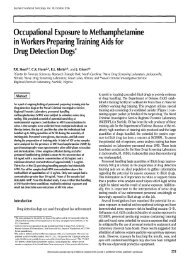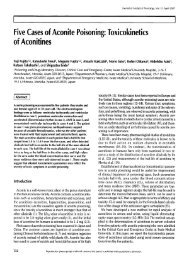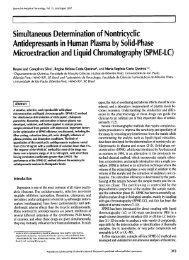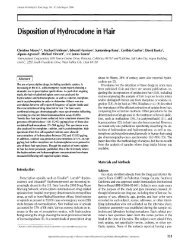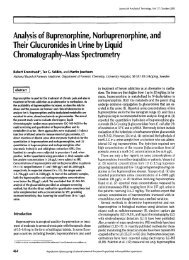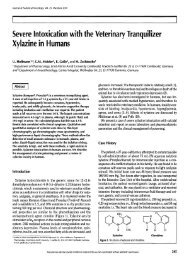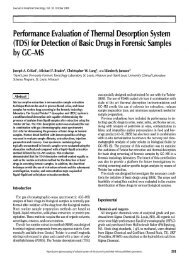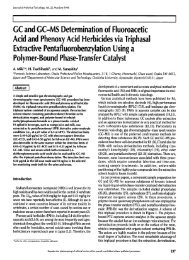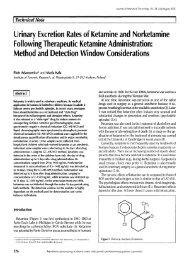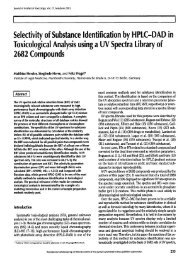A Fatality Due To Alprazolam Intoxication - Journal of Analytical ...
A Fatality Due To Alprazolam Intoxication - Journal of Analytical ...
A Fatality Due To Alprazolam Intoxication - Journal of Analytical ...
You also want an ePaper? Increase the reach of your titles
YUMPU automatically turns print PDFs into web optimized ePapers that Google loves.
] Case Report<br />
A <strong>Fatality</strong> <strong>Due</strong> <strong>To</strong> <strong>Alprazolam</strong> <strong>Intoxication</strong><br />
Amanda J. Jenkins, Barry Levine*, J. taron Locke, and John E. Smialek<br />
Office <strong>of</strong> the Chief Medical Examiner, State <strong>of</strong> Maryland, Baltimore, Maryland<br />
Abstract<br />
<strong>Alprazolam</strong> is one <strong>of</strong> the most widely prescribed benzodiazepines<br />
in the United States. It is generally considered a safe and effective<br />
drug for the treatment <strong>of</strong> anxiety disorders and panic attacks.<br />
Few overdoses that are due to the sole ingestion <strong>of</strong> alprazolam<br />
have been reported. This paper documents a fatality due to<br />
alprazolam intoxication and describes the distribution <strong>of</strong><br />
alprazolam and an active metabolite, (x-hydroxyalprazolam, in<br />
tissues obtained at autopsy. Qualitative identification <strong>of</strong> the drugs<br />
was achieved by full-scan gas chromatography-mass spectrometry,<br />
and quantitative analysis was performed by high-performance<br />
liquid chromatography. High concenlrations <strong>of</strong> alprazolam were<br />
found in all specimens analyzed, but the metabolite was detected<br />
only in subclavian blood, urine, bile, and liver. A postmortem heart<br />
blood alprazolam concentration <strong>of</strong> 2.1 mg/t is the highest<br />
reported in the literature to date.<br />
Introduction<br />
<strong>Alprazolam</strong> (8-chloro- 1-methyl-6-phenyl-4H-s-triazolo<br />
[4,3-c~] [ 1,4] benzodiazepine, Xanax | is one <strong>of</strong> the most widely<br />
prescribed benzodiazepines in the United States. It is com-<br />
monly prescribed for the treatment <strong>of</strong> anxiety and depression<br />
and for sedation (1). It is an effective anxiolytic agent at doses<br />
<strong>of</strong> 0.75-4 mg daily, and doses <strong>of</strong> 6-9 rng per day are prescribed<br />
to treat panic attacks and panic disorders (2). Its precise mech-<br />
anism <strong>of</strong> action is unknown, but, presumably, it acts in a<br />
manner similar to other benzodiazepines by potentiating<br />
GABA. Following oral administration, it is rapidly absorbed<br />
with peak plasma concentrations occurring 1-2 h after inges-<br />
tion. McCormick et al. (3) reported steady-state serum con-<br />
centrations <strong>of</strong> 25-55 ng/mL <strong>of</strong> alprazolam in six individuals<br />
after chronic daily oral administration <strong>of</strong> 1.5-6 rng. Dose-<br />
related increases in steady-state plasma concentrations were<br />
reported with average concentrations reaching 102 ng/mL<br />
after doses <strong>of</strong> 9 rag/day (4).<br />
"Addres ~, R)r c orresponden(e: Dr. Barry Levine, Offi( e (ff the Chief Medical Examiner, 111 Penn<br />
Stret4, Baltimore, MD 21201.<br />
<strong>Journal</strong> <strong>of</strong> <strong>Analytical</strong> <strong>To</strong>xicology, Vol. 21, May/June 1997<br />
<strong>Alprazolam</strong> has a short duration <strong>of</strong> action with an average<br />
plasma half-life <strong>of</strong> 11 h (1). It is extensively metabolized by<br />
oxidation and conjugation with only 20% <strong>of</strong> the parent drug<br />
appearing unchanged in urine (5). The major metabolites are<br />
~-hydroxyalprazolam, 4-hydroxyalprazolam, r<br />
alprazolam, and 3-hydroxy-5-methyltriazolyl chlorobenzo-<br />
phenone (HMTBP). r and 4-hydroxy-<br />
alprazolam are pharmacologically active with approximately 66<br />
and 19% <strong>of</strong> the potency <strong>of</strong> alprazolam, respectively (5). Smith<br />
and Kroboth (6) reported that unconjugated forms <strong>of</strong> these two<br />
metabolites were detected at plasma concentrations <strong>of</strong> less<br />
than 10% <strong>of</strong> the parent drug concentration even after chronic<br />
dosing, and, therefore, their contribution to pharmacological<br />
effects may be minimal in therapeutic cases.<br />
Adverse reactions to alprazolam are typically observed at the<br />
beginning <strong>of</strong> therapy and diminish under continued treatment.<br />
The most common effects reported are drowsiness and fatigue.<br />
Other adverse reactions include confusion, headache, nausea<br />
and vomiting, tachycardia, hypotension, and blurred vision (2).<br />
Abrupt cessation <strong>of</strong> chronic alprazolam therapy has resulted in<br />
withdrawal symptoms, the most important being seizure<br />
activity (2). However, alprazolam is generally considered a safe<br />
and effective drug with a high therapeutic index. Few over-<br />
doses attributable to alprazolam have been reported, and even<br />
fewer fatalities due to alprazolam intoxication without the com-<br />
bination <strong>of</strong> other drugs are documented. In this study, we report<br />
the tissue distribution <strong>of</strong> alprazolam and c~-hydroxyalprazolam<br />
in a death due solely to the ingestion <strong>of</strong> alprazolam.<br />
Case History<br />
The deceased was a 44-year-old white female with a history<br />
<strong>of</strong> psychiatric problems. She was found dead in bed at her res-<br />
idence. Her current medications, which were found at the<br />
scene, included alprazolam, fluoxetine, phenytoin, lorazepam,<br />
and venlafaxine. Although there was a history <strong>of</strong> suicidal<br />
ideation, there was no suicide note.<br />
At autopsy, external examination showed a well-nourished,<br />
218 Reproduction (photocopying) <strong>of</strong> editorial content <strong>of</strong> this ioumal is prohibited without publisher's permission.
<strong>Journal</strong> <strong>of</strong> <strong>Analytical</strong> <strong>To</strong>xicology, Vol. 21, May/]urge 1997<br />
well-developed female. Internal examination was unremark-<br />
able except for 60 mL <strong>of</strong> a white granular substance and 40 mL<br />
<strong>of</strong> a green fluid in the stomach. Microscopic findings demon-<br />
strated mild emphysematous changes in the lungs with intra-<br />
alveolar hemorrhages and focal mild pulmonary edema. Spec-<br />
imens collected for toxicological analysis were stored in sterile<br />
polypropylene containers without preservative and were frozen<br />
at -20~ until assayed.<br />
Methods<br />
Materials<br />
<strong>Alprazolam</strong> and (z-hydroxyalprazolam were purchased from<br />
Sigma Chemical (St. Louis, MO). Chlordiazepoxide was ob-<br />
tained from Alltech Applied Science Labs (State College, PA).<br />
<strong>Analytical</strong>-grade sodium borate was purchased from Mallinck-<br />
rodt (St. Louis, MO), and a saturated solution was prepared for<br />
use as a buffer. Reagent-grade methylene chloride, methanol,<br />
and diethylamine were obtained from Fisher Scientific (Fair<br />
Lawn, N J). Solid-phase extraction columns (Chem Elut TM)<br />
were purchased from Varian (Harbor City, CA).<br />
Procedure<br />
<strong>Alprazolam</strong> and e(-hydroxyalprazolam analytical standards<br />
were prepared in methanol at a concentration <strong>of</strong> 100 mg/L.<br />
Chlordiazepoxide (100 rag/L), the internal standard, was also<br />
prepared in methanol. Internal standard (50 IJL) was added to<br />
2 mL <strong>of</strong> blank blood or case specimen and 2 mL <strong>of</strong> buffer<br />
solution. Standard curves for alprazolam and (z-hydroxyalpra-<br />
zolam were prepared at the following concentrations: 0, 0.5,<br />
1.0, 2.5, and 5 mg/L. Homogenates <strong>of</strong> tissue samples were pre-<br />
pared by adding 1 g tissue to 4 mL distilled water. Samples were<br />
vortex mixed and applied to solid-phase extraction columns.<br />
The tubes were rinsed with 1 mL buffer, which was then applied<br />
to the columns. Drugs were eluted from the column with<br />
2 x 7 mL methylene chloride. The eluent was evaporated to<br />
dryness, and the residue was reconstituted with 400 1JL<br />
methanol. An aliquot was injected onto the high-performance<br />
liquid chromatograph (HPLC) for quantitative analysis. The<br />
assay was linear from 0.2 to 5.0 mg/L with a limit <strong>of</strong> sensitivity<br />
<strong>of</strong> 0.2 mg/L. Drug identification was achieved by full-scan gas<br />
Table I. Tissue Distribution <strong>of</strong> <strong>Alprazolam</strong> and<br />
c~-Hydroxyalprazolam in Overdose Death<br />
Specimen <strong>Alprazolam</strong> (x-Hydroxyalprazolam<br />
Heart blood (mg/L) 2.1 Not detected<br />
Subclavian blood (mg/L) 2.3 0.12<br />
Urine (mg/L) 1.0 1.4<br />
Bile (mg/L) 2.8 1.3<br />
Vitreous humor (rag/L) 0.58 Not detected<br />
Liver (mg/kg) 9,2 0.83<br />
Kidney (mg/kg) 3.8 Not detected<br />
Stomach contents 13 mg in 110 mL Not detected<br />
chromatographic-mass spectrometric (GC-MS) analysis and<br />
comparison with an authentic standard.<br />
HPLC instrument conditions<br />
A Waters (Milford, MA) 501 HPLC pump interfaced with a<br />
Waters 715 Ultra Wisp sample processor, a Waters 490E pro-<br />
grammable multiwavelength detector, and a Hewlett-Packard<br />
(Palo Alto, CA) integrator model 3394A were used for the quan-<br />
titative determination <strong>of</strong> alprazolam and c(-hydroxyalprazolam.<br />
A Beckman (San Ramon, CA) ODS column (15 cmx 4.6-ram<br />
i.d., 5-]Jm particle size) was heated to 30~ The detector wave-<br />
length was 240 nm. The mobile phase consisted <strong>of</strong> methanol<br />
and water (60:40) with 1% diethylamine (pH 6) and a flow<br />
rate <strong>of</strong> 1.5 mL/min.<br />
Results and Discussion<br />
A comprehensive toxicological screen was performed on the<br />
heart blood and urine specimens obtained in this case. This<br />
included ethanol and volatile analysis by headspace GC,<br />
radioimmunoassay for morphine, a liquid-liquid extraction<br />
followed by GC-nitrogen-phosphorus detection (NPD) for basic<br />
drugs, and solid-phase extraction with GC-NPD for acidic or<br />
neutral drugs. In addition, color tests were performed for acetaminophen,<br />
aspirin, and ethchlorvynol. The urine was positive<br />
for alprazolam, chlorpheniramine, dextromethorphan, and<br />
doxylarnine. The heart blood was positive for alprazolam only.<br />
Using the normal base extraction procedure therapeutic concentrations<br />
<strong>of</strong> alprazolam are usually undetected because the<br />
limit <strong>of</strong> detection is 0.1 mg/L. However, in this case, alprazolam<br />
was easily detected by GC-NPD after base extraction was performed<br />
and a full-scan electron impact mass spectrum was<br />
obtained.<br />
Quantitation <strong>of</strong> alprazolam and c(-hydroxyalprazolam in biological<br />
specimens was performed by reversed-phase HPLC.<br />
This procedure is commonly used for the analysis <strong>of</strong> benzodiazepines<br />
(7-9). In this assay, the order <strong>of</strong> elution was<br />
~-hydroxyalprazolam, alprazolam, and the internal standard.<br />
The relative retention times with respect to internal standard<br />
were 0.70 and 0.84 rain for (x-hydroxyalprazolam and alprazolam,<br />
respectively. Chlordiazepoxide was chosen as the<br />
internal standard to enable baseline resolution <strong>of</strong> the three<br />
drugs while optimizing analysis time.<br />
The quantitative results obtained in this case are shown in<br />
Table I. <strong>Alprazolam</strong> was detected in all specimens analyzed.<br />
Concentrations <strong>of</strong> alprazolam >2 mg/L were measured in both<br />
heart and subclavian blood specimens. There was good agreement<br />
in the alprazolam concentration between the two blood<br />
specimens. The alprazolam concentration in liver was approximately<br />
2.4 times the concentration in kidney. The concentration<br />
<strong>of</strong> parent drug measured in bile was approximately three<br />
times the concentration determined in urine, which suggested<br />
that this specimen would be useful for an initial screening for<br />
those assays that are not targeted to drug metabolites. This case<br />
also showed a readily detectable concentration <strong>of</strong> alprazolam in<br />
the vitreous humor. Given the relative protection <strong>of</strong> the vit-<br />
219
eous from putrefactive processes, drug screening may be per-<br />
formed on this tissue in the absence <strong>of</strong> other appropriate spec-<br />
imens. The metabolite r was only detected<br />
in the subclavian blood, urine, bile, and liver specimens.<br />
or was present at 5.2% <strong>of</strong> the concentration<br />
<strong>of</strong> parent drug in the blood, which agrees with the work <strong>of</strong><br />
Smith and Kroboth (6). Therefore, even at fatal concentra-<br />
tions, the relative contribution <strong>of</strong> r to tox-<br />
icity may be minimal.<br />
The tissue distribution <strong>of</strong> alprazolam described in this report<br />
differs from that <strong>of</strong> some other benzodiazepines noted in<br />
fatalities that are due to intoxication. Cardauns and Iffland<br />
(10) described the tissue distribution <strong>of</strong> diazepam and its active<br />
metabolite, nordiazepam, in an intoxication. The concentration<br />
<strong>of</strong> the parent drug was 10 times greater in blood than urine<br />
compared with two times greater concentration in the alpra-<br />
zolam case described in this report. Furthermore, the con-<br />
centration <strong>of</strong> diazepam in the kidney was 20 times less than the<br />
concentration in the liver. In this case, the concentration <strong>of</strong><br />
alprazolam in the kidney was only 2.4 times less than its con-<br />
centration in the liver. Cardauns and Iffland (10) found rela-<br />
tively low concentrations <strong>of</strong> nordiazepam in the tissues ana-<br />
lyzed; the highest concentration was reported in the urine.<br />
This was similar to the distribution <strong>of</strong> cz-hydroxyalprazolam<br />
reported in this study.<br />
In a fatality attributed solely to chlordiazepoxide intoxication<br />
(1), the concentration <strong>of</strong> the parent drug in the blood was<br />
about three times the concentration in urine. Concentrations<br />
in the liver and kidney were approximately equivalent, and<br />
the highest concentration <strong>of</strong> drug in the specimens analyzed<br />
was detected in the bile. Metabolite concentrations were not<br />
reported in this case.<br />
There are only two reports <strong>of</strong> fatal intoxications that were<br />
due to the ingestion <strong>of</strong> alprazolam documented in the litera-<br />
ture. Edinboro and Backer (7) reported a blood alprazolam<br />
concentration <strong>of</strong> 0.177 mg/L in an antemortem hospital<br />
admission specimen from a depressed and suicidal woman. In<br />
another study, Stafford et al. (11) reported a postmortem blood<br />
alprazolam concentration <strong>of</strong> 0.122 mg/L in an acute alpra-<br />
zolam intoxication with concomitant ingestion <strong>of</strong> ethanol<br />
(postmortem blood alcohol concentration = 0.15 g/dL). If the<br />
therapeutic range is considered to be 0.025-0.102 mg/L,<br />
depending upon low- or high-dose therapy, the alprazolam<br />
concentrations determined in both <strong>of</strong> the previous fatalities<br />
were 1.2-7.1 times therapeutic levels. In comparison, the mean<br />
blood concentration determined in this case was 22-90 times<br />
greater than the therapeutic range. These concentrations are<br />
the highest reported in the literature to date.<br />
220<br />
Conclusion<br />
<strong>Journal</strong> <strong>of</strong> <strong>Analytical</strong> <strong>To</strong>xicology, Vol. 21, May/June 1997<br />
Following the completion <strong>of</strong> the investigation and the eval-<br />
uation <strong>of</strong> the autopsy and toxicology findings, the medical<br />
examiner ruled the cause <strong>of</strong> death as acute alprazolam intoxi-<br />
cation. Given the past psychiatric history <strong>of</strong> suicidal ideation<br />
and the alprazolam concentration in the blood, the manner <strong>of</strong><br />
death was ruled suicide.<br />
References<br />
1. R.C. Baselt and R.H. Cravey. Disposition <strong>of</strong> <strong>To</strong>xic Drugs and<br />
Chemicals in Man. 4th ed. Chemical <strong>To</strong>xicology Institute, Foster<br />
City, CA, 1995.<br />
2. Physicians' Desk Reference. 48th ed. Medical Economics Data<br />
Production, Montvale, N J, 1994.<br />
3. S.R. McCormick, J. Nielsen, and P. Jatlow. Quantification <strong>of</strong><br />
alprazolam in serum or plasma by liquid chromatography. Clin.<br />
Chem. 30:1652-55 (1984).<br />
4. D.A. Ciraulo, J.G. Barnhill, H.G. Boxenbaum, D.J. Greenblatt, and<br />
R.B. Smith. Pharmacokinetics and clinical effects <strong>of</strong> alprazolam<br />
following single and multiple oral doses in patients with panic dis-<br />
order. J. Clin. Pharmacol. 26:292-98 (1986).<br />
5. G.W. Dawson, S.G. Jue, and R.N. Brogden. <strong>Alprazolam</strong>. A review<br />
<strong>of</strong> its pharmacodynamic properties and efficacy in the treatment<br />
<strong>of</strong> anxiety and depression. Drugs 27:132--47 (1984).<br />
6. R.B. Smith and P.D. Kroboth. Influence <strong>of</strong> dosing regimen on<br />
alprazolam and metabolite serum concentrations and tolerance to<br />
sedative and psychomotor effects. Psychopharmacology 93:<br />
105-12 (1987).<br />
7. L.E. Edinboro and R.C. Backer. Preliminary report on the appli-<br />
cation <strong>of</strong> a high performance liquid chromatographic method<br />
for alprazolam in postmortem blood specimens. J. Anal. <strong>To</strong>xicol.<br />
9:207-208 (1985).<br />
8. R.L. Miller, and C.L. DeVane. <strong>Alprazolam</strong>, o~-hydroxy- and 4-<br />
hydroxyalprazolam analysis in plasma by high performance liquid<br />
chromatography. ]. Chromatogr. 430:180-86 (.1988).<br />
9. V.D. Schmith, S.R. Cox, M.A. Zemaitis, and P:D. Kroboth. New<br />
high-performance liquid chromatographic method for the deter-<br />
mination <strong>of</strong> alprazolam and its metabolites in serum: Instability <strong>of</strong><br />
4-hydroxyalprazolam. J. Chromatogr. 568:253-60 (1991).<br />
10. H. Cardauns and R. Iffland. Ueber eine toedliche Diazepam<br />
(Valium) Vergiftung bei einem drogenabhaengigen Jugendlichen.<br />
Arch. <strong>To</strong>xicol. 31:147-51 (1973).<br />
11. D.T. Stafford, A.M. Phillips, G.S. Fernandez, and H.S. Nichols.<br />
Xanax (alprazolam)---An overdose death. Abstract. American<br />
Academy <strong>of</strong> Forensic Sciences Annual Meeting, Anaheim, CA,<br />
February 23, 1984.<br />
Manuscript received July 29, 1996;<br />
revision received October 25, 1996.



